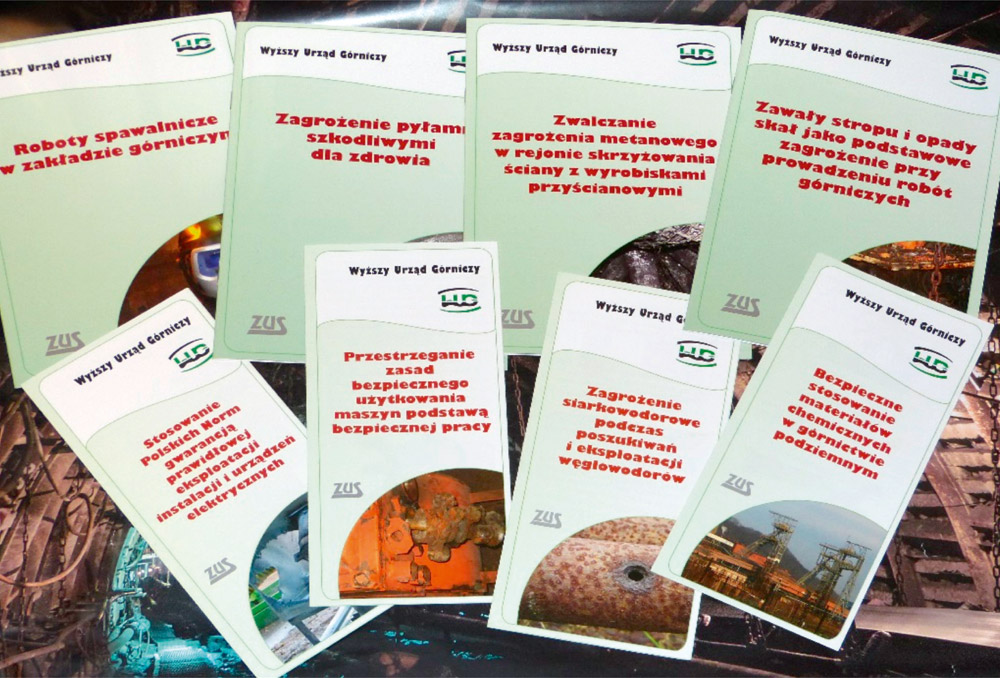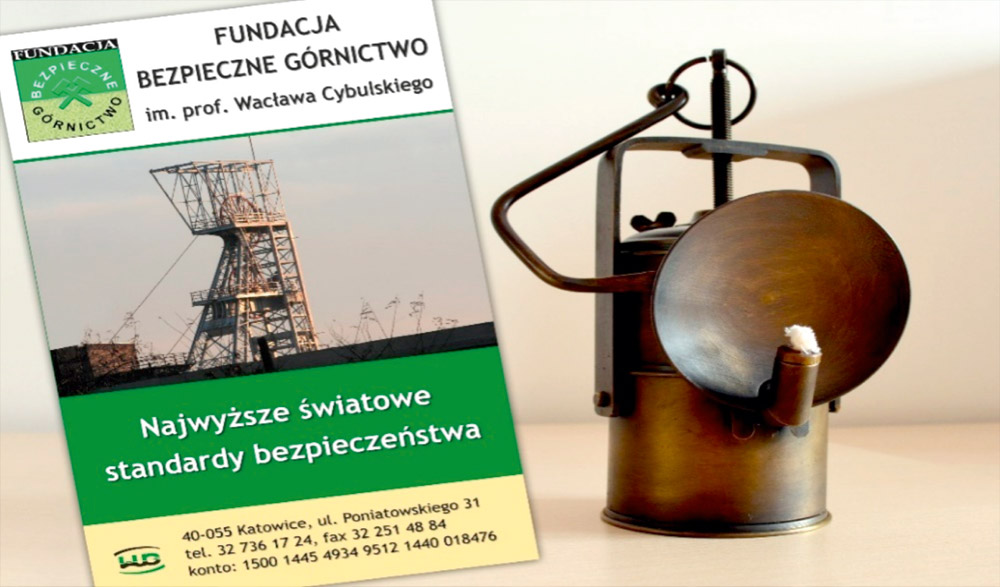1 The role of the mining supervisory authority
The mining supervisory authorities include:
1) the President of the State Mining Authority;
2) directors of the district mining offices, hereinafter referred to as “OUG”;
3) the Director of the Specialised Mining Office, hereinafter referred to as “SUG”.
Mining supervisory authorities, fulfilling their social mission including improvement of the occupational health and safety for the mines, optimum management of mineral deposits and limitation of adverse effects of the mining industry on people and the environment, are implementing the objectives contained in the “Strategy of operation of the mining offices for 2015 to 2018”.
The following strategic objectives have been assumed for the occupational health and safety:
- limitation of the number of accidents caused by the so-called human factor;
- limitation of the number of accidents and dangerous incidents, connected with the products used in the mining industry;
- effective prevention of mining disasters;
- limitation of the scale of occupational diseases in the mining industry;
- effective enforcement of legal regulations within the scope of the occupational health and safety in the mining industry;
- adapting legal solutions to the requirements of the effective management of the occupational health and safety in the mining industry; and
- maintaining of effectiveness of the mining rescue teams.
In 2016 the mining supervisory authorities implemented tasks specified in the provisions of the act of 9th June 2011 – Geological and Mining Law and the provisions of the other acts controlling the supervision and inspection of operation of the mines and in the implementing acts for these acts. It includes in particular:
- occupational health and safety;
- fire safety;
- mine rescue;
- management of minerals deposits during extraction and environmental protection;
- preventing damages; and
- construction and liquidation of the mine, including land reclamation and development of land after mining operations.
Furthermore, they supervised and inspected:
- entities dealing with professional mine rescue works;
- entities executing in professional activity the entrusted operations in the mines;
- execution of geological works;
- training of people executing operations in mines or executing the geological works; and
- enterprises executing underground works using mining technology.
The Geological and Mining Law imposed on the mining supervisory authorities an obligation to issue the administrative decisions in case when they state operation without required concession within the scope of exploration or prospection of minerals or extraction of minerals from the deposits.
The supervision and inspection of the mining enterprises covers 7,289 mines as at 31st December 2016, including:
- 40 underground mines:
- 23 mines extracting hard coal, one mine under construction and nine mines in liquidation (extraction: approximately 70.4 mt);
- three copper ore mines (extraction: approximately 33.6 mt);
- one zinc and lead ores mine;
- one salt mine;
- one gypsum and anhydrite mine; and
- one curative brine mine.
- 7,233 surface mines:
- 15 mines covered with mining property, including without limitation: eleven lignite mines (extraction: approximately 59.6 mt); and
- 7,218 mines covered with right of ownership of the real property.
- 95 mines extracting minerals using boreholes, including:
- Nine oil and gas plants, including: 57 crude oil mines or natural gas mines, seven underground gas storages and two sea mines (output: approximately 1 mt of crude oil and 5,11 bn m3 of natural gas);
- 73 healing, thermal waters and brine plants; and
- three plants extracting coalbed methane.
The supervision and inspection covers also 179 offices executing geological works. More than 180,000 employees have been employed in the mining industry as at 31st December 2016.
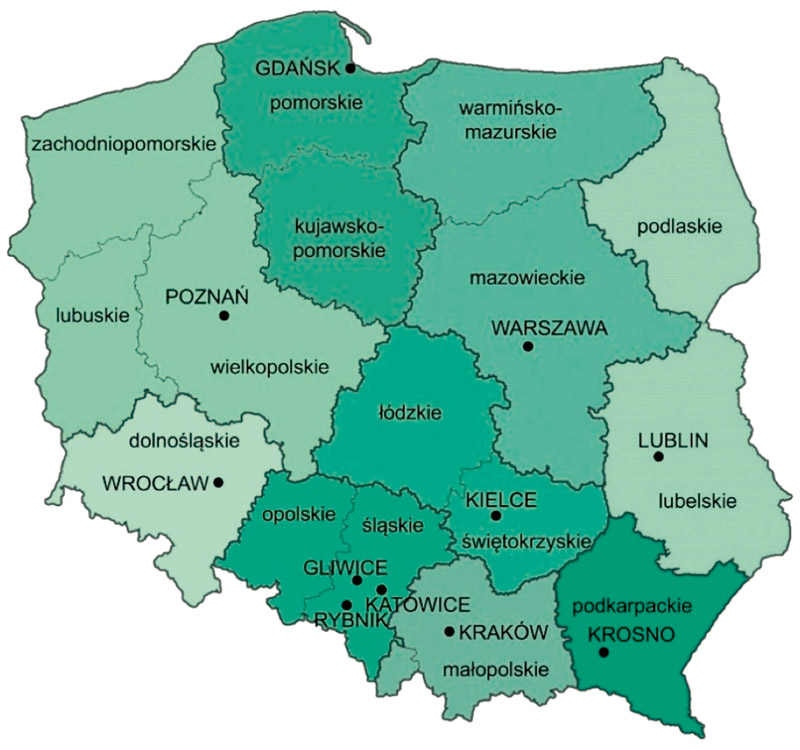
Fig. 1. Territorial coverage of the mining authorities. // Bild 1. Zuständiggebiete der Bergaufsichtsbehörden.
Inspection and supervision of operating the mines, entities executing geological works and the entities executing entrusted operations in the mines is carried out by:
- 68 technical and inspection service staff members at the State Mining Authority;
- 263 technical and inspection service staff members in eleven district mining offices and at SUG. Territorial coverage for the individual offices is presented in figure 1.
2 State of the occupational safety in the mining industry in 2016 (comparison since 2012)

Table 1. Accident rates in the mining industry between 2012 and 2016. // Tabelle 1. Unfallzahlen im Bergbau in den Jahren 2012 – 2016.
A total number of accidents has been decreasing in the Polish mining industry over the past years. 11,866 accidents were reported in the mining industry between 2012 and 2016 (Table 1), where 77.1 % applies to accidents in hard coal mines, 16.7 % in copper ore mines, 2.9 % in surface mines and 1.3 % in borehole mines and companies executing geological works. A total of 2,074 accidents were reported in 2016 in the Polish mining industry, that is 735 (26.2 %) less than in 2012, including 27 fatal accidents, nine serious accidents and 433 accidents involving employees from the entities executing the entrusted operations in the mines (Table 2).

Table 2. Accident rates in the mining industry in 2016. // Tabelle 2. Unfallzahlen im Bergbau im Jahr 2016.
The main reasons of the accidents in 2016 for the whole mining industry include:
- tripping, slipping or tipping over of people (28.0 %);
- falling down, rolling down of rock lumps or falling of rocks from side wall and roof (19.7 %);
- hitting by tools or other objects (13.9 %); and
- falling down, rolling down or sliding down of objects or materials (11.8 %).
27 fatal accidents – eight more than in 2015 – and nine serious accidents – three less than during the previous year – were reported in the whole mining industry in 2016. The main reasons of fatal and serious accidents in 2016 include:
- dynamic impacts of effects of the tremors (rockburst, decompression);
- falling of rocks from roof and side walls;
- staying within the range of operation of machinery and equipment;
- hitting by horizontal transport equipment;
- falling from height;
- working on belt and scraper conveyors during their operation;
- electrocution or burning by electrical arc;
- incorrect work organization;
- risky behaviour of employee and supervision staff; and
- working under influence of alcohol.
Main reasons of the accidents occurred between 2012 and 2016 were of similar type as the reasons of the accidents in 2016, that is:
- breaking down and falling of the rocks from the roof;
- dynamic impacts of effects of the tremors (rockburst, decompression);
- explosion and ignition of methane;
- working on belt and scraper conveyors during their operation;
- hitting by horizontal transport equipment; and
- staying within the range of operation of self-propelled machinery.
Figure 2 shows the accident´s development from 2012 to 2016 graphically.
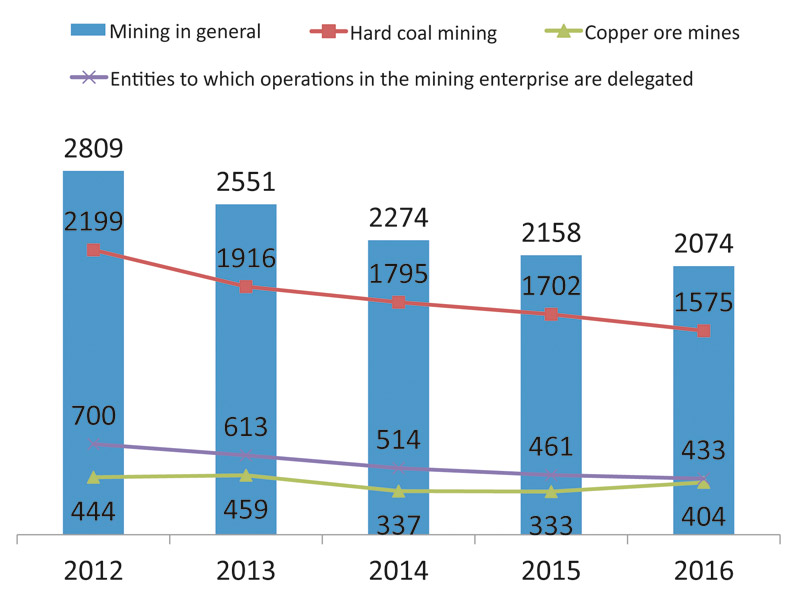
Fig. 2. Number of total accidents in the mining industry between 2012 and 2016. // Bild 2. Unfallzahlen insgesamt im polnischen Bergbau in den Jahren 2012 bis 2016.
The most fatal and serious accidents in the Polish mining industry from 2012 to 2016 involved the employees having one to ten years of experience (47.4 %) and with more than 20 years years of experience (30.1 %). It is a strange and worrying fact that almost a third of fatal and serious accidents involved the most experienced personnel, with more than 20 years of experience (Figure 3).
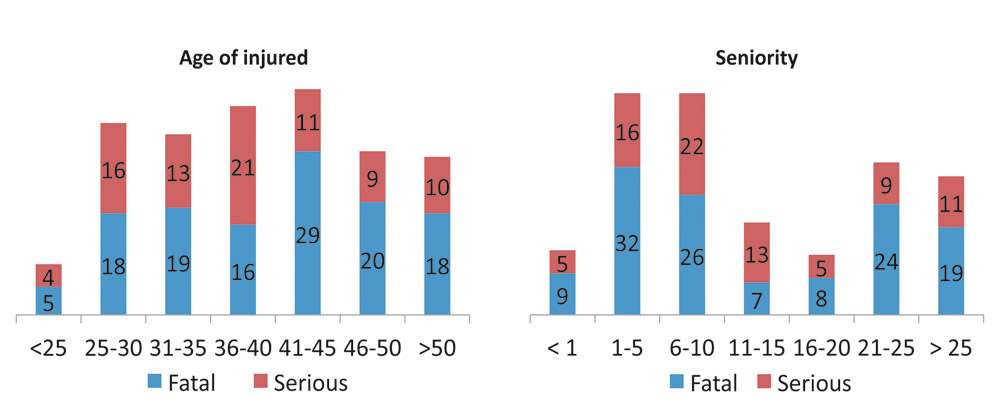
Fig. 3. Fatal and serious accidents according to the employee´s age and seniority. // Bild 3. Tödliche und schwere Unfälle nach Lebens- und Dienstalter der Beschäftigten.
Due to that fact that the number of employees in the mining industry decreases, what applies in particular to the hard coal mining industry a more reliable information on trends of accident rates may be represented by total accident rates for the whole mining industry – presented in broader time frame, where the decreasing trend is as clearly visible – and for fatal accidents in hard coal and copper ore mining industry (Figures 4, 5, 6).
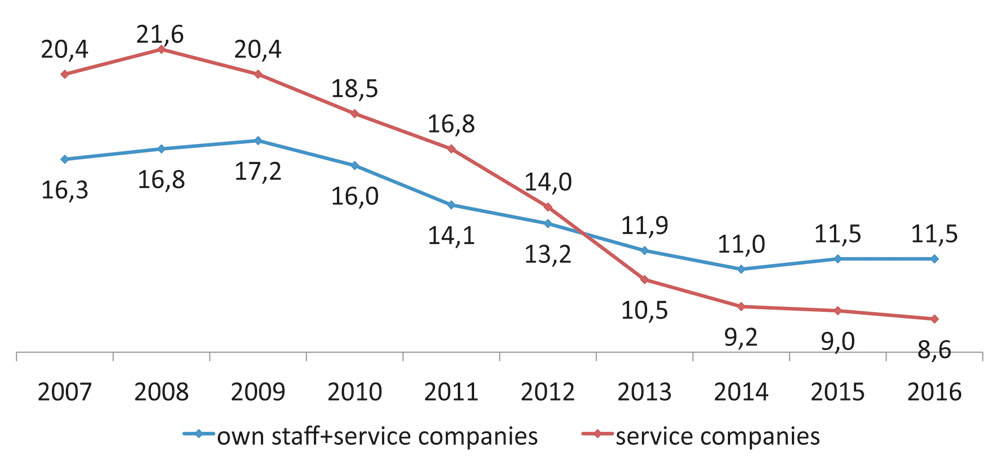
Fig. 4. Number of total accidents in the mining industry between 2012 and 2016. // Bild 4. Unfallgesamtzahlen pro 1.000 Bergbaubeschäftigte in den Jahren 2007 bis 2016.
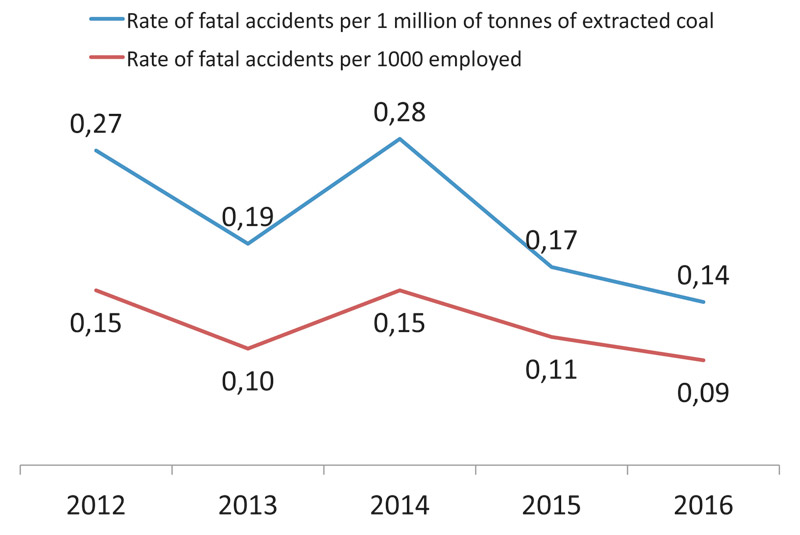
Fig. 5. Rate of fatal accidents per 1 mt of extracted copper ore and per 1,000 employees from 2012 to 2016. // Bild 5. Tödliche Unfälle pro 1 Mio. t gewonnene Steinkohle sowie pro 1.000 Bergbaubeschäftige in den Jahren 2012 bis 2016.

Fig. 6. Rate of fatal accidents per 1 mt of extracted coal and per 1,000 employees from 2012 to 2016. // Bild 6. Tödliche Unfälle pro 1 Mio. t gewonnenen Kupfererzes sowie pro 1.000 Bergbaubeschäftige in den Jahren 2012 bis 2016.
3 Inspection and repressive activity of the mining supervision authorities
In 2016 the technical inspection staff members in OUG and SUG worked 21,956 man-days, while technical inspection staff members in WUG worked 2,077 man-days within the scope of inspections in the mines and other units and entities subjected to inspections and supervision of the mining supervision authorities, as well as within the scope of identification and fighting hazards in the mines, connected with determination of actual state and causes of the accidents, incidents and supervision of rescue actions.
As a result of conducted controls and visual inspections of locations of accidents and hazardous incidents a total of 1,656 mining operations, and operation of machinery and equipment, were stopped in 2016. The most stops in the hard coal mines were caused by incorrect condition of the electrical power and mechanical equipment – 1,006.
Due to stated irregularities the employees of OUG, SUG and WUG filed 188 motions for penalty to the district courts to punish people offending the regulations, filed 1,300 motions to the entreprTotal accident rates per 1,000 employees in the Polish mining industry from 2007 to 2016.arnings, as provided for in Art. 41 of the Code of Administrative Offences, and fined 1,064 people with fixed penalty notices for the total amount of 446,530 PLN in 2016. Furthermore, the President of the State Mining Authority issued, with respect to management and maintenance supervision personnel in the mines, executing their operations with gross negligence or gross breach of applicable regulations, eight final decisions stating ban on execution of the specified operations for a period to two years.
4 Preventive actions undertaken by the mining supervision authorities
In the course of implementation of the designated objectives, the State Mining Authority continues to conduct a series of activities and initiatives intended for protection of health, life and improvement of the safety. Inspections of the mines and companies executing geological works related to natural and technical hazards, deposits management and environmental protection are carried out within the scope of preventive operations. Works executed in methane, crump and fire hazard conditions are subject to special supervision. To decrease the rates of accidents caused by a so-called human factor, to eliminate risky behaviours of the employees and to increase awareness and responsibility of the staff employed by the mining companies the State Mining Authority conducts preventive operations which are implemented by:
1 Participation in social campaigns related to occupational safety.
- Participation in the Campaign of the European Agency for Safety and Health at Work in 2007 called: “LIGHTEN THE LOAD CAMPAIGN” extended in 2008 for the Polish mining industry on the initiative of the State Mining Authority (WUG).
- The social campaign entitled “Occupational risk in the mining industry”, organized within the scope of the European Campaign on Risk Assessment, was held under honorary patronage of the President of the State Mining Authority in 2009.
- The State Mining Authority joined the European Information Campaign for Safe Workplaces concerning safety of machinery, equipment and buildings in 2010.
- The social campaign entitled “ACCIDENT PREVENTION”, was held under honorary patronage of the President of the State Mining Authority in 2012.
2 Organisation of conferences, e. g. seminars together with the Management Board of the Association of Mining Engineers and Technicians (SITG) entitled: “OCCUPATIONAL HEALTH AND SAFETY ISSUES IN THE POLISH MINING INDUSTRY” – the 18th edition of the conference was organized in 2016 – which is part of a cycle of meetings related to actions undertaken to improve occupational safety to people employed in all kinds of mines in the mining industry.
The President of the State Mining Authority together with the “Safe Mining Industry Foundation” named after Prof. Wacław Cybulski, organized a competition from 15th May 2016 to 31st October 2016: “180 days without an accident at the beginning”, which was held under a honorary patronage of the President of the Republic of Poland Andrzej Duda. An idea of this competition was to limit the number of accidents and to promote prevention in underground mines.
3 Organisation of meetings and conferences with the management of individual mines, OHS employees and the representatives of social labour inspectorate (SIP) within the scope of actions intended to improve occupational health and safety in the mining industry.
4 Organisation of informational meetings with the supervisory personnel of the mines, with trainings promoting so-called good practices in the mining industry.
5 Organisation of meetings with face men of heading and longwall crews and prop drawer crews in all underground mines taking into consideration issues of safe execution of the works in places where hazards related to falling rocks from roof and side wall is present.
6 Activity of the conciliation teams. The dominant type of cooperation of the mining offices with the local government bodies was an activity of the conciliation and consultation teams. The directors of the district mining offices appoint such teams and their main task is to create amicable conditions for mining extraction under the lands of the mining communes and correct coordination of design, preventive and repair works. The directors of the mining offices convened 22 meetings with twelve from existing 16 conciliation teams for periodical assessment of the impact of mining extraction on areas within the administrative boundary lines of the towns (communes), under which the underground mining is conducted.
7 Trainings and cooperation with the Social Insurance Institution (ZUS). Mining supervisory authorities had conducted supervision and inspection over training of personnel conducting operations in the mining companies to ensure a correct level and high quality of the employee´s trainings in the mines. Inspections conducted in 2016 in the mines and organizational units dealing with training of personnel executing operations in the mines, related to having appropriate staff and necessary measures allowing to ensure necessary training, indicated a series of irregularities in relation to which it was necessary to issue a decisions imposing removal of stated irregularities and to impose penal sanctions to the individuals guilty of misconduct.
Within the scope of cooperation with ZUS in Warsaw, started in 2009, the employees of the mining offices conducted 53 trainings, including 12 one-day seminars for a staff of underground mines in 2016, with participation of approximately 400 people, on the following subjects:
- Methane and fire hazard control.
- Working in rock bursts and falling of the roof hazard conditions.
- Operational safety of transport systems. Transport of personnel on belt conveyors – good practices.
- Scope of basic obligations and requirements for the management and OHS staff or entities conducting entrusted operations in the mines.
Furthermore, a training movie was prepared and recorded in 2016 related to rock burst hazards and falling of rocks from the roof and side wall in hard coal and copper mines.
Five more training movies were prepared within the scope of cooperation of the ZUS. These movies related to hazards occurring in the mining industry. In addition, many brochures and leaflets were issued on the following subjects (Figure 7):
- stop to noise;
- incorrect equipment;
- climate hazards;
- rock burst and falling of the roof hazard;
- mining explosives – your powerful but also dangerous friend;
- entities conducting entrusted works in the mines within the scope of their business activity;
- explosion hazard in borehole mining;
- rockburst hazard;
- preparing the workplace for a wireman;
- observance of safe rules of machinery operation as a basis for safe work;
- polish Standards – proven rules of technology used in the mining industry;
- safe use of chemicals in the underground mining; and
- hydrogen sulphide hazard during exploration and extraction of hydrocarbons.
Training materials in form of handbooks were also prepared on the following topics:
- safety and functionality of control systems of the mining machinery and equipment;
- organization of work on the electrical equipment and systems;
- safety during carrying out of shaft works;
- safe transport of personnel in the underground mines; and
- prevention within the scope of control of dusts harmful for health.
Prepared training materials were handed over to the mining companies, service providing companies conducting works in the mines and training centres within the scope of preventive actions to use them in their training activities.
8 Publishing.
The academic journal “Occupational safety and environment protection in the mining industry” has been issued since 1992. Between 1992 and 1996, it has been issued as a quarterly journal and since 1996, following the decision of the President of the State Mining Authority it is issued every month.
A tab “Occupational health and safety in the mining industry” is available on the website of the State Mining Authority. In this tab, the most interesting project related to improvement of safety and elimination of risky behaviours is promoted.
9 Foundations and competitions.
The aim of the foundation “Safe Mining Industry” named after Wacław Cybulski, founded in 1997, is to achieve the highest world standards by the Polish mining industry within the scope of the occupational health and safety. The foundation awards the prize “Silver Treasurer” for outstanding achievements and services to the Polish mining industry, safe extraction of minerals, identification of natural hazards and safety of mining staff and honours the best diploma thesis related to safety issues. This prize was awarded to many people and institutions meritorious for the mining industry.
The foundation covers all institutions connected with the mining industry and contributes to improvement of social image of the extractive industry by promoting the occupational safety, reliable machinery and equipment and safe management systems. The foundation organizes with interested partners competitions and initiatives of great interest of the mining industry, including:
- “Safe department” competition, promoting model behaviours in the most troublesome workplaces;
- Art competition “Modern mining industry: miner and driller works safely. 21st century mine”, promoting mining among secondary school children;
- “Safe mine” competition, co-organized by the School of Underground Mining and the State Mining Authority;
- “Brave miner” honourable mention, awarded for a special attitude having impact on the safety;
- “Karbidka” competition, with prizes awarded to people widely connected with a mass media, presenting to general public issues connected with the extractive industry in a reliable way (Figure 8).
Every year the foundation awards the best diploma thesis connected with safety issues prepared by the students from mining classes.
5 Activities of the special committees
The president of the State Mining Authority is obliged to appoint the committees to give opinions on a general safety, related to the operation of a mine, occupational safety state in the mining industry and state of identification and fighting of hazards in the mines. The following committees were operating in 2016:
- Committee for Occupational Safety in the Mining Industry preparing and submitting the opinions related to occupational safety state in the mining industry to the President of the State Mining Authority;
- Committee for Surface Protection giving opinions on general safety state, connected with the operation of the mines;
- Committee for Hazards in Underground Hard Coal Mines, giving opinion on investigation and fighting of hazards – in particular rock burst and falling of the roof hazards, methane hazard, gas and rocks breakouts, fire and climatic hazard, coal dust explosion and water hazards;
- Committee for Hazards In Underground Mines Extracting other Minerals than Hard Coal, with objective to give opinions on investigation and fighting of hazards in particular rock burst and falling of the roof hazards, methane hazard, gas and rocks breakouts, fire and climatic hazard, coal dust explosion and water hazards.
6 Actions taken to implement conclusions of the post-accident committees.
A strategic research project has been started in 2010 on the motion of the President of the State Mining Authority due to absence of the implementation of parts of the motions directed to the research and scientific units, resulting from works of the committee, appointed between 2000 and 2010 to investigate causes and circumstances of the disasters in the mines: “Occupational safety improvement in the mines”, which was announced by the National Centre for Research and Development – an institution supporting Polish research units and companies in developing capabilities to create and use the solutions based on the results of the scientific research. The research project consists of the following tasks:
- Preparation of a new classification of natural hazards in underground mines with experimental verification.
- Preparation of rules for the design of mining works in locations where methane and fire hazards are present in the aspect of ventilation systems in underground hard coal mines.
- Preparation of rules for measurements and tests of mine air parameters to assess the methane and fire hazard in underground hard coal mines.
- Improvement of the effectiveness of methane drainage in conditions of high concentration of the extraction in underground hard coal mines.
- Preparation of rules for employment in climatic hazard conditions in underground mines.
- Preparation of solutions with measurement instrumentation allowing to carry out measurements and diagnosis of power cables and conductors where methane or coal dust explosion hazard is given.
- Preparation of a functional wireless rescue communication system with option to use where methane or coal dust explosion hazard is given.
- Preparation of a gasometric system causing the immediate shutdown of the power supply for the machinery and equipment in case of a sudden outflow of methane from old excavations to the operating excavations.
- Determination of a correlation coefficient between the automatic measurement of air velocity and the averaged value of velocity measurement by manual anemometers.
- Preparation of a management system controlling fatigue of the miners in underground hard coal mines.
- Preparation of working clothes for mine rescue men.
- Preparation of an orientation and signalling direction for the retreat of the staff on escape routes in longwall galleries.
The introduction of final products for the implementation of individual subjects in the mines will result in a limitation of hazards and an improvement of occupational safety in the areas, where most of the accidents occurred during the last years. The President of the State Mining Authority appointed in January 2015 a team for the analysis of final products of the above-mentioned research tasks. Its priority task is to assess completed research tasks by transformation of resulting conclusions into practical use in the mines by the introduction of new legal regulations or revision of the current applicable regulations, observations of manuals, guidelines or standards and promoting good practices.
